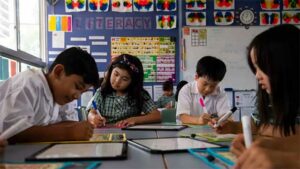Home » Commentary » Opinion » Pandemic is yet to teach us its true lessons
· Australian Financial Review

 Reassuring NAPLAN results offer hope that Australian students may escape serious educational harm from the pandemic. However, it would be premature to put the concerns to bed just yet.
Reassuring NAPLAN results offer hope that Australian students may escape serious educational harm from the pandemic. However, it would be premature to put the concerns to bed just yet.
The recently announced results – based on exams sat in May this year – suggest Australian students, on average, are achieving no better or worse than before the pandemic.
And despite Victorian students suffering about half a year of school closures, there’s little evidence of a marked difference in their progress compared with other states – including where schools were closed for as a little as one week.
That will ease the worries of families, educators and analysts who feared the worst – that COVID-induced school closures might result in catastrophic and irreversible declines in achievement.
At home and abroad, initial indicators over the past year have painted a troubling picture.
NAPLAN check-in assessments – intended to give an early look into possible impact of school closures – revealed that students were well behind those of previous years; roughly equivalent to the period schools were closed.
That conclusion is consistent with findings in international research. In the Netherlands – where schools were closed for a similar duration to NSW and Queensland – students made little or no progress while learning from home.
CIS research also estimated relatively modest learning losses for Australia’s disadvantaged students, particularly where schools were closed longest.
Polling found 40 per cent of Australian parents worried their children progressed more slowly while learning at home. In a similar poll of French parents, about 60 per cent thought their child’s progress was impaired.
Against these dire predictions, the news on NAPLAN is certainly welcome, but is perhaps not as surprising as it appears.
It’s important to consider what NAPLAN measures and what it doesn’t. Unlike subject-specific assessments – like the HSC or VCE – that test topic knowledge, NAPLAN tracks students’ foundational literacy and numeracy capabilities.
Faced with the challenge of the pandemic, a back-to-basics approach helped to focus efforts of parents and educators.
That meant the core needs of students were reasonably well met throughout by home-based learning and in the immediate return to school – while extraneous, nice-to-have content was trimmed. And in NSW and Victoria, policymakers offered extra tutoring programs to remedy students lagging in literacy and numeracy.
In any case, the apparent NAPLAN success must be greeted with caution, as the weight of pandemic’s impact on education is yet to be seen.
More detailed results later this year will give insight on how different students have fared. The real test will be tracking the progress of Australia’s most educationally vulnerable students – not just the average ones. After all, it’s these students who are most likely to have fallen behind.
Moreover, the impact of school closures may be felt more widely than in NAPLAN alone. Recent data has shown disturbing trends in the mental health and wellbeing of children who have suffered from time away from school. Many anecdotal reports also point to concerning absenteeism of students who disengaged while schools were closed. Again, it will be forthcoming data that may reveal a more telling story.
It’s also the case that school closures are not yet behind us – and thus, too soon to conclude the threat has been averted. Many students – especially those in NSW – will miss more face-to-face learning this year than they did before sitting the 2021 NAPLAN tests.
On top of that, lockdown fatigue has set in more gravely now than it had earlier. And since adverse impacts on learning are likely to be cumulative, we may be yet to see the true effect on student achievement. In other words, next year’s NAPLAN may be more revealing than this year’s.
Like other COVID-related matters, looking at one indicator and data point in isolation can be misleading. More information – including retention, attendance, and other achievement markers – must be part of any calculation before declaring learning losses are beaten.
The Prime Minister boasts that Australia has averted the worst of both the health and economic consequences of the pandemic. Time will tell if this will be true for education too.
For now, however, it is too soon for policymakers, educators and parents to assume there is little reason to lose sleep over lost learning.
Pandemic is yet to teach us its true lessons